What to be on the lookout for…
Cross-Striped Cabbageworms
The cross-striped cabbageworm (CSCW) has become a significant pest of brassicas in Connecticut. It is different from other major caterpillar pests because it lays eggs in batches of 3-25, not singly. Egg batches are flat yellow clusters attached to the underside of the leaf. Infested plants have many caterpillars and often leave the plant completely skeletonized. They can also target terminal buds and sprouts and may burrow into heads. Scout weekly for caterpillars and damage. Spray if 5% of the plants are infested. Use selective insecticides to preserve parasitic wasps.
While scouting for CSCW, it’s a good idea to be on the lookout for other brassica caterpillar pests including those of the imported cabbageworm (ICW) and diamond back moth (DBM). Damage of ICW includes round or ragged feeding holes and deposits of wet, green or brownish frass. When disturbed, DBM wiggle vigorously and may drop off the plant on a string of silk. DBM feeding causes small, round holes and tends to be spread across the foliage rather than concentrated in the head.
Scout fields by checking leaves (top and bottom) on 25 plants across the field. In the Northeast, there is generally no need to treat young plants unless weather conditions delay plant development and at least 35% of plants are infested with ICW and/or DBM. Treat plants between the start of heading and harvest if 20% or more of the plants are infested. The most critical time to scout and apply chemical controls is just before head formation. Use a 10-15% threshold throughout the season for kale, collards, mustard, and other leafy greens. But remember the threshold for CSCW is 5%. Spray recommendations can be found on the New England Vegetable Management Guide.
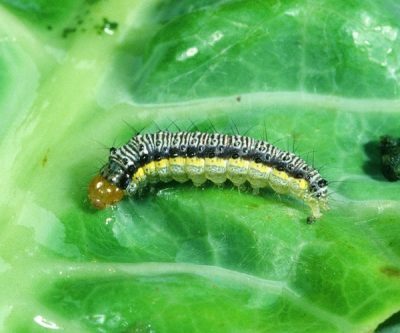
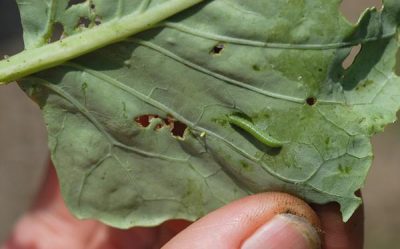
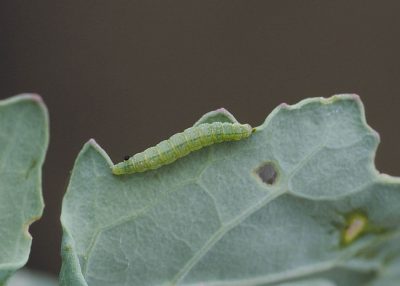
Tomato Hornworms in High Tunnels
The adult tomato hornworms are large moths, predominantly gray or gray-brown with lighter markings. Their hairy, robust abdomens have yellow spots. They are commonly referred to as sphinx, hawk, or hummingbird moths. The wingspread may reach five inches.
Spot treat areas within a high tunnel using selective insecticides to preserve natural enemies and avoid secondary pest outbreaks (i.e. aphids). Products containing BT (e.g. Dipel and XenTari) are effective and should be rotated for resistance management. These products must be ingested, so apply in the evening or early morning before larvae are actively feeding. Adherence will improve with use of approved spreader-sticker.

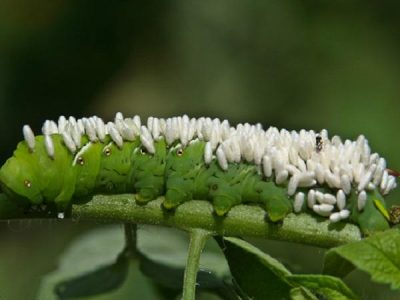

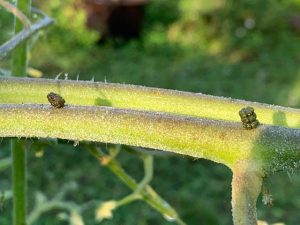
Cucurbit Downy Mildew: Early Arrival In CT This Season
Cucurbit downy mildew (DM) was reported in New Haven county on July 2, 2025. It normally takes 3-5 days in the weather we currently have for a new infection to manifest visual symptoms. Therefore, cucumber growers should start including downy mildew targeted fungicides in their spray program in addition to preventative products. Some examples of targeted fungicides are Orondis Opti (M05, 49), Previcur Flex (28), Ranman (21), Zing! (22, M05). For organic options, LifeGard, Serenade, and Double Nickel are labeled.
While it does not infect cucurbit fruit directly, DM will cause the leaves to die prematurely resulting in yield losses and decreased fruit quality. For up-to-date information on management strategies for DM, along with detailed spray options, visit the New England Vegetable Management Guide. The UConn Extension Vegetable Team is also available to support growers with developing spray programs specific to your needs. Email Shuresh Ghimire at shuresh.ghimire@uconn.edu or text us with photos/questions at 959-929-1031.


Sweet Corn Pests - Trap Count Update
| Location | CEW (avg per night) | ECB - NY | ECB - IA | ECB - III | FAW |
| Glastonbury A | 0 | 0 | 0 | 0 | 0 |
| Glastonbury B | 2.7 | 0 | 0 | 0 | 2 |
| Berlin | 1.5 | 0 | 0 | 2 | - |
| Shelton | 1 | 2 | 0 | 2 | 0 |
Note: We caught wainscot moths in FAW traps on two farms. So, it's important to accurately ID the moth.
Spray Intervals for Corn Earworm

See the New England Vegetable Management Guide for detailed management strategies for all sweet corn insect pests.
New Resource: Managing Flood Risks on Farms
Our team at UConn Extension has put together a factsheet to help you navigate flood risks on your farm. From preparing before a big storm to dealing with the aftermath, this short guide covers practical steps to help protect your crops, soil, and equipment. With more extreme weather events happening across the region, it's a good time to think about how to reduce damage and recover safely if flooding occurs.
Continue to be on the lookout for...
Striped and Spotted Cucumber Beetles
Flea Beetles: Brassica and Solanaceous
Squash Vine Borer (high numbers reported this week!)
Want the New England Vegetable Management Guide and/or Northeast Vegetable and Strawberry Pest ID Guide at your fingertips?
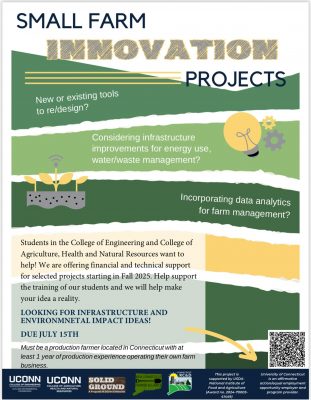
Small Farm Innovations
Project Forms
Due Soon! July 15th
Students in the UConn College of Engineering and College of Agriculture, Health and Natural Resources want to help farmers make their infrastructure and environmental impact ideas become a reality.
Must be a production farmer located in Connecticut with at least 1 year of production experience operating their own farm business.
Submit your application for the Small Farm Innovations Project today!
Stay in touch with us
- Share what you see: We're here to assist with identification, management strategies, and guidance on best practices. Send us a photo/message via text at 959-929-1031.
- Facebook Group: UConn Extension moderates a private Facebook group specifically for commercial vegetable producers. It is a space to share photos of insects and diseases you find in your fields, ask questions, share ideas, and stay engaged with growers across the state. Join the "UConn Extension - Vegetable IPM" Facebook Group
- Schedule a consultation: Would you benefit from meeting with an Extension Specialist at your farm to provide insight on pest or disease identification, management strategies, and more? If so, please contact our Vegetable Extension Specialist, Shuresh Ghimire, to setup a farm visit. Contact him at shuresh.ghimire@uconn.edu or 860-870-6933.
Contact Information
Shuresh Ghimire, Vegetable Extension Specialist: shuresh.ghimire@uconn.edu
Nicole Davidow, Vegetable Extension Outreach Assistant: nicole.davidow@uconn.edu
Vegetable IPM Office Phone Number:
860-870-6933
Vegetable IPM Cell Phone Number:
959-929-1031 (feel free to text/iMessage photos)
Vegetable IPM Pest Alert Audio Recording:
860-870-6954
Thank you for reading!
This report was prepared by Nicole Davidow, Outreach Assistant, and Shuresh Ghimire, Commercial Vegetable Specialist, UConn Extension.

The information in this document is for educational purposes only. Any reference to commercial products, trade or brand names is for information only, and no endorsement or approval is intended. Always read the label before using any pesticide. The label is the legal document for product use. Disregard any information in this report if it is in conflict with the label. UConn Extension does not guarantee or warrant the standard of any product referenced or imply approval of the product to the exclusion of others which also may be available. The University of Connecticut, UConn Extension, College of Agriculture, Health and Natural Resources is an equal opportunity program provider.
